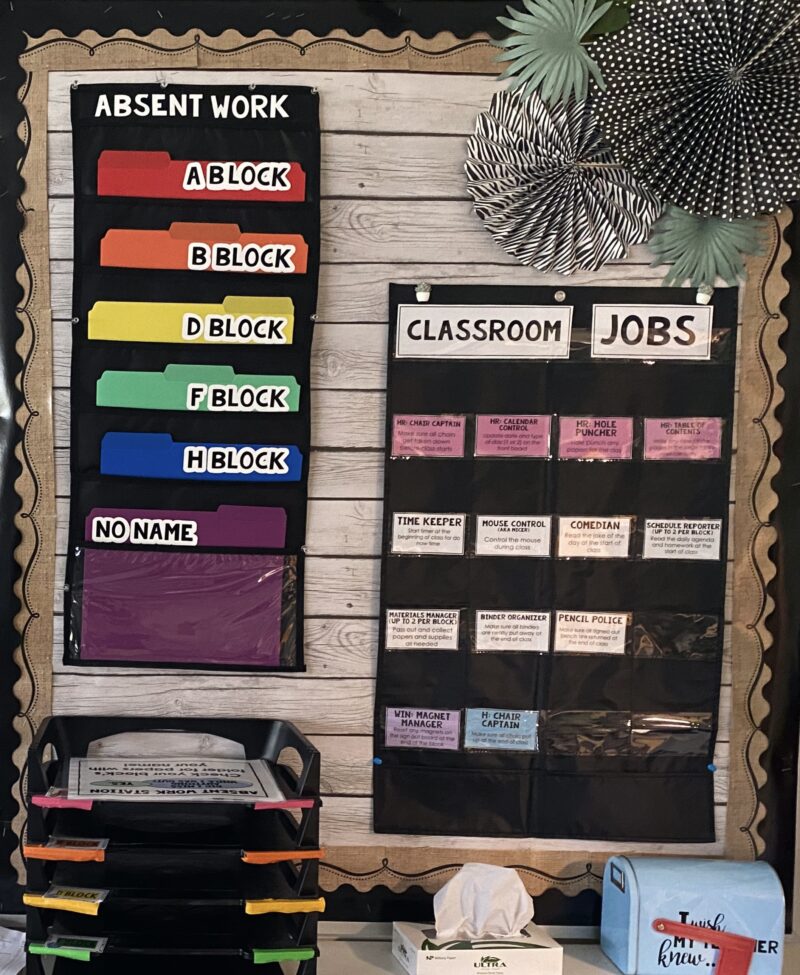It’s an all too familiar scenario: You planned an awesome lesson and your kids totally got it. You’re ready to move on, when a student enters the room with the dreaded question:
“Did we do anything important yesterday?”
Cue the inevitable searching your desk for the extra handout you set aside for them. Meanwhile, you’re funneling your remaining energy into suppressing the urge to snap back with a sarcastic, “No. We missed you too much to work, so we spent the class watching Disney shorts and making cootie catchers.” (Or maybe not suppressing. No judgment here.)
Here’s how I’ve tried to cut down on the crazy of catching up with absent students, and the new system that I’ll be implementing this year (just in time for nationwide record numbers of chronic absenteeism).
Where I started
As a first-year teacher, I attempted to implement a personalized mailbox system. Each class period has a milk crate with a file folder for each student. As the photo shows, this system took up a lot of precious space. My entire back countertop was dedicated to managing students’ absent work. The amount of space dedicated to this system definitely was outsized compared to the frequency it was used. Individualized mailboxes are a great resource in elementary classrooms with 30 or fewer students. But mailboxes just weren’t working for the 100+ students in my secondary space.
Round two
When I pivoted to a new system in the next year, it was a drastic swing in the opposite direction. In an attempt to save time setting up and counter space, I pared down to a single milk crate. This was dubbed the Extra Copies Bin, and it stored all leftover handouts from a lesson. The bin was frequented by students who misplaced or needed to revise an assignment, in addition to absent students. I would add each page in an individual file folder to the crate, and use a label at the top to note the number and title of the page. With this system, I’d be labeling one or two file folders every day or so rather than 100+ folders at a time. This was appealing, since the hours of typing, cutting, and assembling that went into the mailbox system were still fresh in my mind.
The idea of the Extra Copies Bin was simple. When students returned from an absence, they would first check the large table of contents on display in our room. Then, they would pick up any pages added during their absence from the bin. In theory, this sounds easy enough. But middle schoolers have a way of circumventing our best-laid plans.
The reality was the system required too many steps for my middle schoolers. First, they had to check the large TOC and cross-reference it with their own (which, gasp, may not be accurately updated!). From there, they needed to identify the page in the Extra Copies Bin. Finally, students needed to check with me for an expected due date.
It worked … to an extent. But the system didn’t run as independently as I wanted. Additionally, students could get confused and grab a page they already had rather than the one they needed. While this may be a realistic system for high school students, my middle schoolers needed a little more guidance. It became my mission to marry the compactness of the Extra Copies Bin with the scaffolding of the mailboxes.
What I’m using now
As previously mentioned, space and ease of setup were big concerns in adopting a new system. After perusing social media for other teachers’ ideas, I settled on a hanging option. Following a few days of indecisiveness, I settled on this hanging file organizer to house my students’ absent work.
To set up this system, I assigned each class period a color. I already use a color-coding system to organize student binders and turn-in trays (shown in the bottom left corner of the photo below), so it was easy to keep the theme going. The organizer I chose came with labels, but I opted to make my own using removable vinyl and my Cricut for a little extra flair. Because I now only teach five class periods, I designated the final folder for those dreaded no-name submissions.

So, how does it work?
When a student is absent, I’ll take a copy of the handout we’re using that day and write their name and expected due date on it in pen. Using pen is important if you have kiddos that may want to take some creative liberties with the due date! I train students to check the folder for pages with their name following an absence, and they don’t need to ask when the page is due. Should they forget and ask me what they missed, they can be quickly directed to the class folder to claim their work.
An additional bonus of this system? When a no-name paper comes in, I can write the block of the turn-in tray it was placed in and file it in the bottom “no name” folder. No more rifling through my grading binder to hunt for no-name pages, or performing forensic analysis to track down the owner.
A perfect blend
This system preserves the important parts of the original mailbox and extra-copy systems, blending them to work in my classroom. Students are still responsible for checking for their absent work and completing it in a timely manner. But the system meets them where they are with respect to organization skills and executive functioning. Not to mention, I’m able to reclaim precious space and get the added benefit of organizing their no-name work. I have high hopes for this system!
For more articles like this, be sure to subscribe to our newsletters.
title_words_as_hashtags